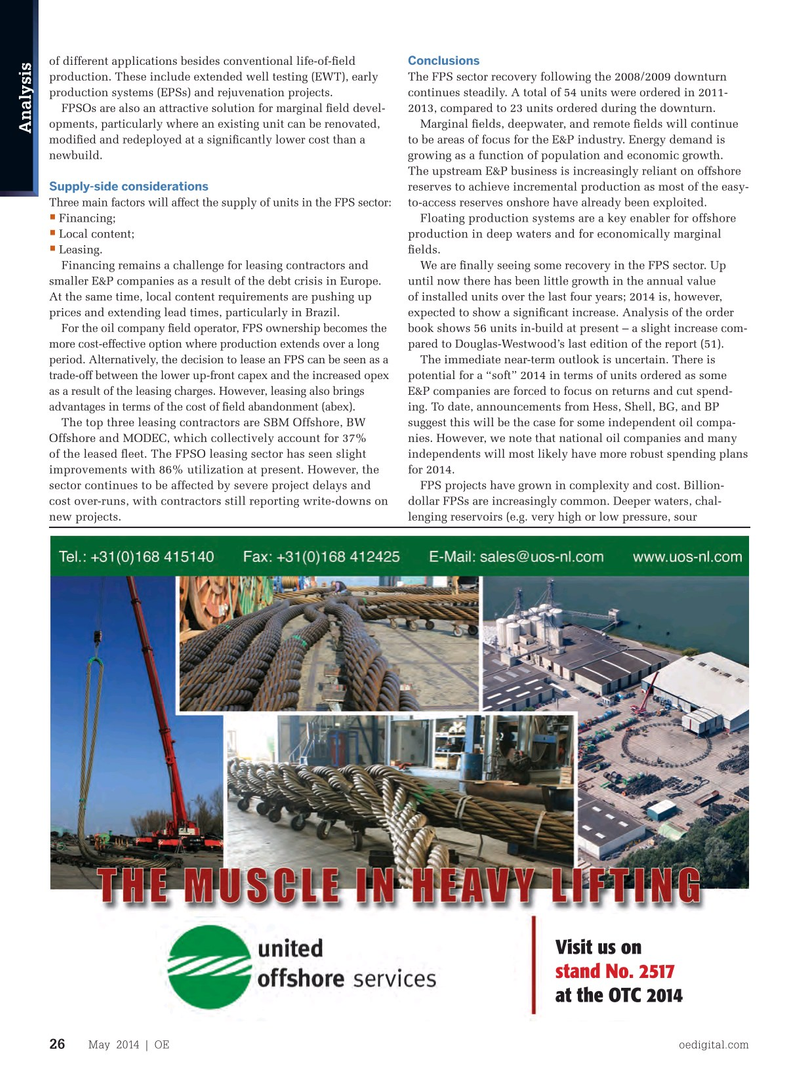
Page 24: of Offshore Engineer Magazine (May/Jun 2014)
Read this page in Pdf, Flash or Html5 edition of May/Jun 2014 Offshore Engineer Magazine
of different applications besides conventional life-of-feld Conclusions production. These include extended well testing (EWT), early The FPS sector recovery following the 2008/2009 downturn production systems (EPSs) and rejuvenation projects. continues steadily. A total of 54 units were ordered in 2011-
FPSOs are also an attractive solution for marginal feld devel- 2013, compared to 23 units ordered during the downturn.
Marginal felds, deepwater, and remote felds will continue opments, particularly where an existing unit can be renovated,
Analysis to be areas of focus for the E&P industry. Energy demand is modifed and redeployed at a signifcantly lower cost than a growing as a function of population and economic growth. newbuild.
The upstream E&P business is increasingly reliant on offshore
Supply-side considerations reserves to achieve incremental production as most of the easy-
Three main factors will affect the supply of units in the FPS sector: to-access reserves onshore have already been exploited.
Financing; Floating production systems are a key enabler for offshore •
Local content; production in deep waters and for economically marginal •
Leasing. felds.
•
Financing remains a challenge for leasing contractors and We are fnally seeing some recovery in the FPS sector. Up smaller E&P companies as a result of the debt crisis in Europe. until now there has been little growth in the annual value
At the same time, local content requirements are pushing up of installed units over the last four years; 2014 is, however, prices and extending lead times, particularly in Brazil. expected to show a signifcant increase. Analysis of the order
For the oil company feld operator, FPS ownership becomes the book shows 56 units in-build at present – a slight increase com- more cost-effective option where production extends over a long pared to Douglas-Westwood’s last edition of the report (51).
period. Alternatively, the decision to lease an FPS can be seen as a
The immediate near-term outlook is uncertain. There is trade-off between the lower up-front capex and the increased opex potential for a “soft” 2014 in terms of units ordered as some as a result of the leasing charges. However, leasing also brings
E&P companies are forced to focus on returns and cut spend- advantages in terms of the cost of feld abandonment (abex). ing. To date, announcements from Hess, Shell, BG, and BP
The top three leasing contractors are SBM Offshore, BW suggest this will be the case for some independent oil compa-
Offshore and MODEC, which collectively account for 37% nies. However, we note that national oil companies and many of the leased feet. The FPSO leasing sector has seen slight independents will most likely have more robust spending plans improvements with 86% utilization at present. However, the for 2014.
sector continues to be affected by severe project delays and FPS projects have grown in complexity and cost. Billion- cost over-runs, with contractors still reporting write-downs on dollar FPSs are increasingly common. Deeper waters, chal- new projects. lenging reservoirs (e.g. very high or low pressure, sour
Visit us on stand No. 2517 at the OTC 2014
May 2014 | OE oedigital.com 26 027_OE0514_Analysis1-DouglasWestwood.indd 26 4/20/14 11:35 AM

 23
23

 25
25